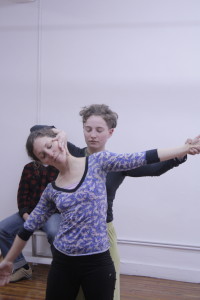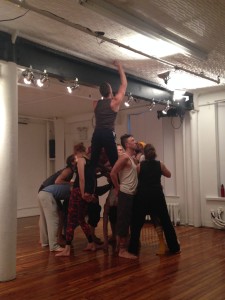For dance performances, most people avoid one of my favorite seats. I like to sit on the side where a portion of the stage is obstructed. Although I miss some of the performance, this inadvertently offers a sliver of a view backstage. Between the side skirts, I can often see dancers standing at the edge of the stage awaiting their entrance. I love watching them shake out their limbs, roll their heads and then take a few deep breaths before a long, relaxing release. For that moment they are unmistakably human. Then they step across the invisible threshold onto the stage and suddenly transform into ethereal beings moving with a fluid radiance that enraptures everyone in the audience.
Art is transformation. It is not an object. It is an action. The static media associated with art such as paintings, books and sculptures, are only the means through which the artist applies her talent and concentration to refine and recreate herself. Through this, the artist touches the audience and opens opportunities for the audience to transform themselves. The reality of art is not in the object; it is in the mind. Art is alive.
This is one of the principle allures to dance. The medium is not inert material. Essentially, it is not a system of symbolic language. In dance, the medium is life itself. This creates continuity in the expression between the choreographer and the audience that makes a truly moving experience. No other expression speaks to our nature more directly or honestly.
Four Sunday afternoons, over a period of six weeks, Orietta Crispino, the artistic director of TheaterLab, opened the studios to reveal art as more than a production, but a process. Orietta declares, “Art comes from necessity.” Through the creation and the staging of a performance, numerous variables and elements must be addressed. These are demands where the script offers no stage directions and must be resolved with the resources and ingenuity that can be mustered on the spot. Through this, the performances are specifically shaped to work within the staging space, but most importantly, to work within the venue of the audience’s attention.
Hotel New York allows performance artists to take short-term residence at TheaterLab and reveal the creative process to the audience, and more importantly, allow the audience to participate in this process. The specific series of Revealing Dances is an open studio with two dance projects. Melissa Riker with Kinesis Project Dance Theatre collaborated with a talented group of dancers to produce Secrets and Seawalls. The other project, Babel, was co-produced by Jeremy Williams of Convergences Theatre Collective and W.T. McRae of Tiny Giraffe Theater. Both productions proved wonderful complements for each other, confirming one another in some ways, while diverging with contrasts in others.
Ms. Riker explained that the original idea of Secrets and Seawalls was the comparison between vulnerability and power. Through this, she took a more collaborative relation with the dancers. Ms. Riker declared elements and topics, often in the form of simple phrases, that she allowed the dancers to elaborate with the distinctness of their own lives.
In one part, referred to as “mine,” the dancers move in contorted and awkward postures while announcing ownership of particular gestures. The expressions assert the dynamics between declaration and referral, claiming and relinquishing ownership through statements while the dancers exhibits the movements through their own actions of their own bodies. Although the piece was introduced as “simultaneous solos” instead of an ensemble, the statements create kinetics in speech so that even without contact between the dancers, they couple and repel one another through sporadic blurts of “mine” and “yours”.
Various other parts were also presented, some directed by Ms. Riker, others developed by the dancers individually. The audience was able to witness how these modular pieces grew together into a singular whole, finding an ever-changing form and shape in the way they all worked together.
The other dance develops from a more singular narrative following the story of the Tower of Babel. Babel demonstrates a palpable illustration of the bottom-up system of arrangement. Typically, we tend to consider systems as top-down. We focus upon a single prominent feature by which we define the arrangement. However, this prominent feature is only a secondary result of the accumulation from below.
Babel opens with an ensemble of paired dancers. In each pair, one dancer directs the other through an exploration of their physical nature: lifting appendages, opening hands, carrying the partner from one place to the other for position. In doing this separately, the pairs inadvertently discover a singular direction defined by their common nature and circumstance. As this progresses, the separate actions of the partners begin to coincide resulting in a beautiful unison in the synchronization of movement. Typically, we consider direction as dictating our movement. This performance clearly demonstrates how direction is simply a result of movement.
 As the pairs continue to converge upon the common, they squeeze together to form an ascending tower with the pinnacle occupied momentarily by a single dancer rapidly rising to the peak from the mashing pressure from below. Then as quickly as the dancer ascends, the dancer descends and is replaced by another. The group becomes a singular organism growing in one convulsive spurt after another. Without props or elaborate explanations, the interactions of the dancers illustrate the realities of social dynamics, which, after all, are directed by the movement of our individual and collective nature.
As the pairs continue to converge upon the common, they squeeze together to form an ascending tower with the pinnacle occupied momentarily by a single dancer rapidly rising to the peak from the mashing pressure from below. Then as quickly as the dancer ascends, the dancer descends and is replaced by another. The group becomes a singular organism growing in one convulsive spurt after another. Without props or elaborate explanations, the interactions of the dancers illustrate the realities of social dynamics, which, after all, are directed by the movement of our individual and collective nature.
Through the rehearsals, the audience often participated in the creative process, asking questions and offering suggestions. This brought a more direct collaborative exercise into the choreography. Through the Open Studio, Orietta intended to remove the critical opposition and instead increase the participation. Through this, the artistic expression becomes a more perfect collective experience.
After the rehearsals, chairs were gathered for a round discussion with the artists and the audience. Two mediators, Jennifer Edwards and Homer Frizzell, were introduced and the topic of defining an “artistic lifestyle” was initiated. Jennifer, a dancer, choreographer and writer, declared “Art is not something you do. Art is something you are.” From this, the distinctions between the necessities of practical reality and the drive for creative expression were balanced and Homer provided explanations from his own life where he is an accomplished writer and photographer who, through necessity, makes his living as a banker. Everyone seemed to agree that creativity was demanded from every aspect of life in society and that we may all benefit with a greater creative participation of everyone. There is no audience in society as we are all essential participants in creating what we are together. This is especially important as we all continue to strive to achieve the timeless aspiration that is shared by everyone – to make a living through doing what we love.












melissariker
Garrett, thank you so much for this article – this phrase “…we may all benefit with a greater creative participation of everyone.” is exactly the reason we invented this series! That an open door to invention and problem solving in a creative process might inform our viewers lives inside, and outside of art, and art viewing.